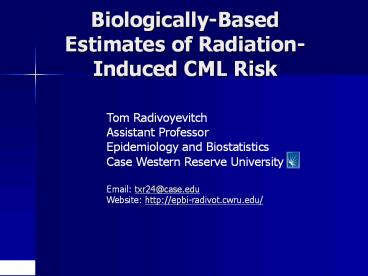Biologically-Based Estimates of Radiation-Induced CML Risk - PowerPoint PPT Presentation
Title:
Biologically-Based Estimates of Radiation-Induced CML Risk
Description:
UDP CDP GDP ADP dTTP dCTP dGTP dATP dT dC dG dA DNA dUMP dU TS DCTD dCK DNA polymerase TK1 cytosol mitochondria dT dC dG dA TK2 dGK dTMP dCMP dGMP dAMP dTTP dCTP ... – PowerPoint PPT presentation
Number of Views:71
Avg rating:3.0/5.0
Title: Biologically-Based Estimates of Radiation-Induced CML Risk
1
Biologically-Based Estimates of Radiation-Induced
CML Risk
Tom Radivoyevitch Assistant Professor Epidemiology
and Biostatistics Case Western Reserve
University Email txr24_at_case.edu Website
http//epbi-radivot.cwru.edu/
2
(No Transcript)
3
Linear Risk Model
Using the BCR-ABL to CML waiting time density
and the linear model
we maximized the log-likelihood
4
Model of Radiation-Induced CML Risk
A linear-quadratic-exponential model of CML risk
is
where
D?i and Dni are the gamma and neutron doses in
gray
N is the number of CML target cells per adult
P(baT) is the probability of BCR-ABL given a
translocation
This is a one-stage model of carcinogenesis.
5
BCR-to-ABL 2D distances in lymphocytes
Kozubek et al. (1999) Chromosoma 108 426-435
6
Theory of Dual Radiation Action
P(baD) probability of a BCR-ABL translocation
per G0/G1 cell given a dose D tD(r)dr expected
energy at r given an ionization event at the
origin
intra-track component inter-track
component Sba(r) the BCR-to-ABL distance
probability density g(r) probability that two
DSBs misrejoin if they are created r units
apart Y 0.0058 DSBs per Mb per Gy ? mass
density TBCR 5.8 kbp TABL 300 kbp
7
Estimation of g(r)
?d? in .01, .025, ?dx in .04, .05, ?d
in .05, .06
G35 DSB/Gy per cell 6.25 kev/um3 1 Gy
R 3.7 um ? r0 0.24 ?m, p0 0.06
8
(No Transcript)
9
Model of Radiation-Induced CML Risk
A linear-quadratic-exponential model of CML risk
is
where
D?i and Dni are the gamma and neutron doses in
gray
N is the number of CML target cells per adult
P(baT) is the probability of BCR-ABL given a
translocation
This is a one-stage model of carcinogenesis.
10
(No Transcript)
11
Figure 3 Hypersensitivity ratios in the
literature (left panel) and the log-survival dose
response for T98G human glioma cells (right
panel). Figures from Joiner, M.C., Marples, B.,
Lambin, P., Short, S.C. and Turesson, I.,
Low-dose hypersensitivity current status and
possible mechanisms. Int J Radiat Oncol Biol Phys
(2001) 49 379-389.
12
Discussion
- CML low incidencegt CML risk estimates will not
change protection policies gt low priority for
funding - Focus on well understood systems to connect basic
science to epi-data. Works better in cancer
therapy, e.g. gleevec. - Specialize modelers to become experts in
biological literatures Tyson career model
13
dNTP Supply System
flux activation inhibition
nucleus
ADP
dATP
dA
GDP
dGTP
DNA
dCK
dG
dCTP
CDP
RNR
ATP or dATP
mitochondria
dC
dTTP
UDP
DCTD
cytosol
cytosol
5NT
TS
dA
dAMP
dATP
dUMP
dUDP
dGK
dT
dG
dGMP
dGTP
dU
dUTP
dUTPase
dC
dN
dCMP
dCTP
TK2
dT
dTMP
dTTP
NT2
dN
Figure 1. dNTP supply. Many anticancer agents act
on or through this system to kill cells. The most
central enzyme of this system is RNR.
14
CASE ICBP Problem Statement
Damage Driven or S-phase Driven
Focus on nucleoside analogs
dNTP demand is either
Salvage
Metabolism of dNTPs Analogs
Metabolism of DNA Drug-DNA
De novo
Focus on cancers caused by DNA repair system
failures
DNA repair
For Example
15
Carcinogenesis and Therapy
- Childhood leukemia treatments as carcinogen
exposures secondary AMLs account for 50 of
treatment failures whole lifetimes to see solids
arise. - System models (e.g. dNTP supply) can be applied
to carcinogenesis and therapy - Focus on well understood cancers first. Cannot
cure everyone - cannot predict risks of all
compounds for all endpoints.































